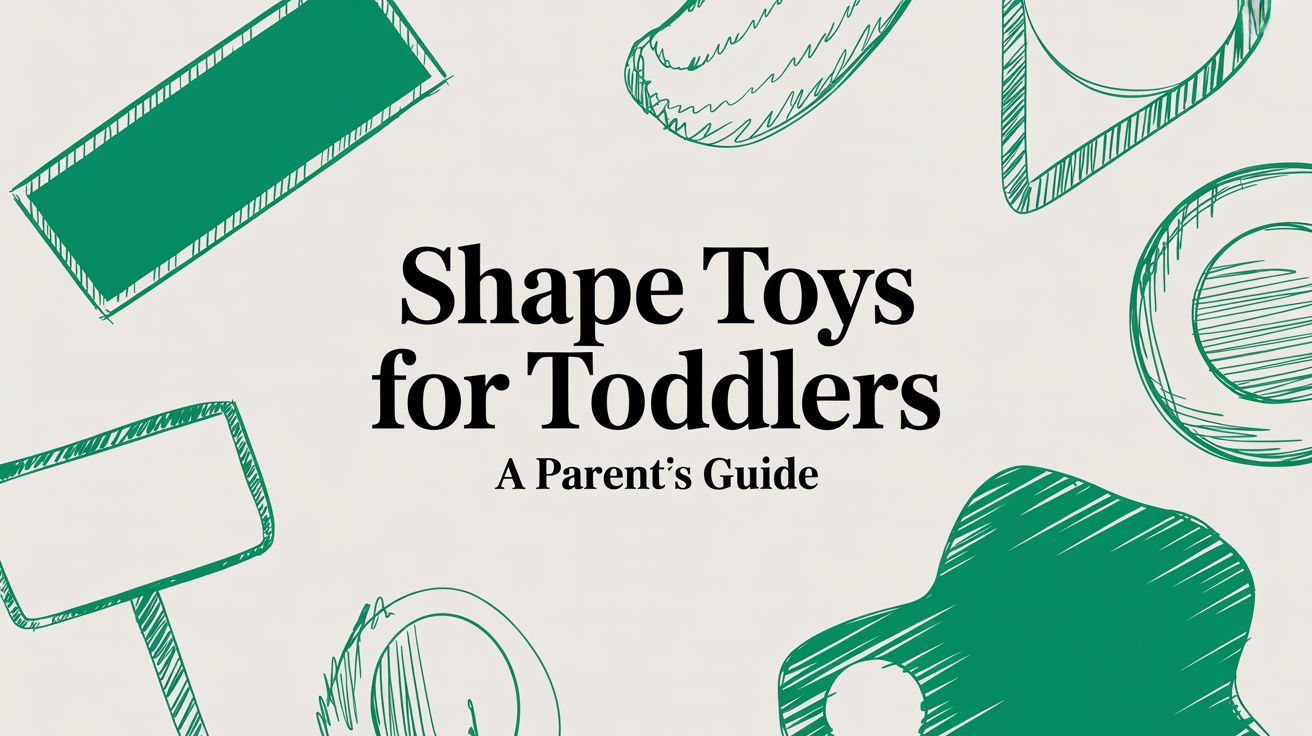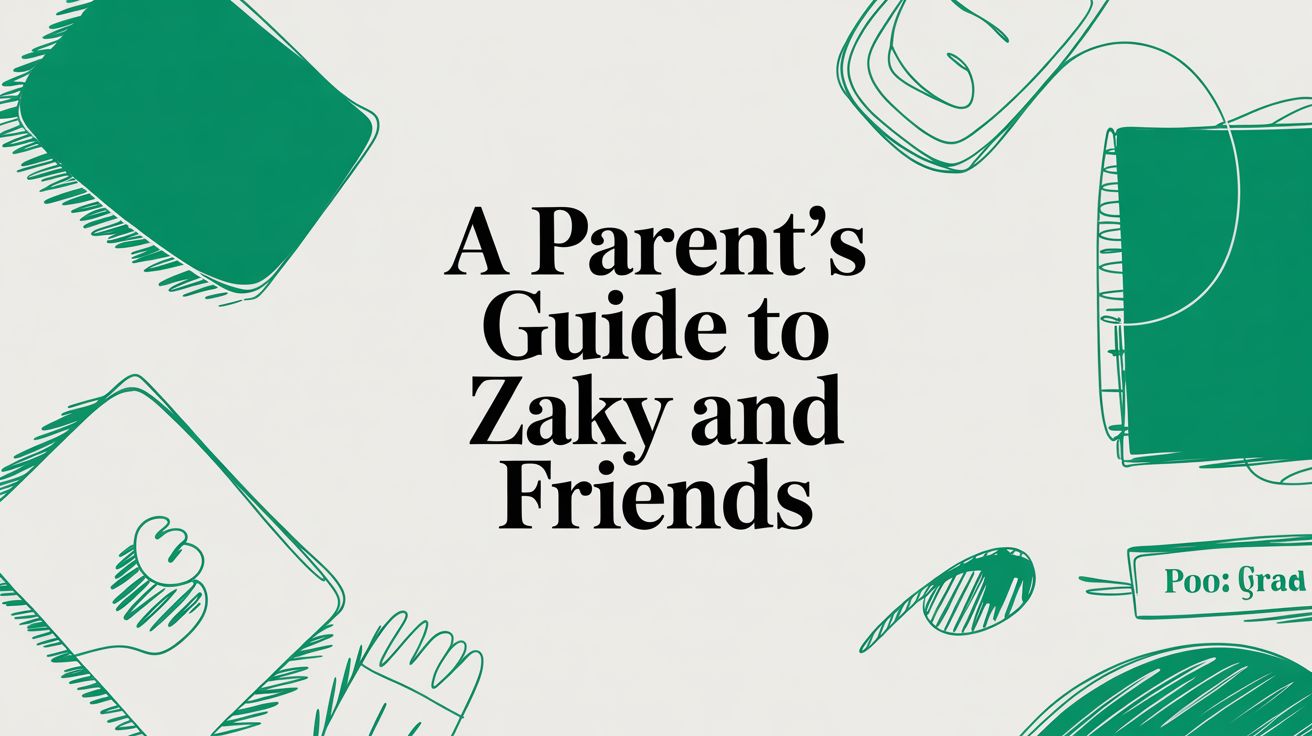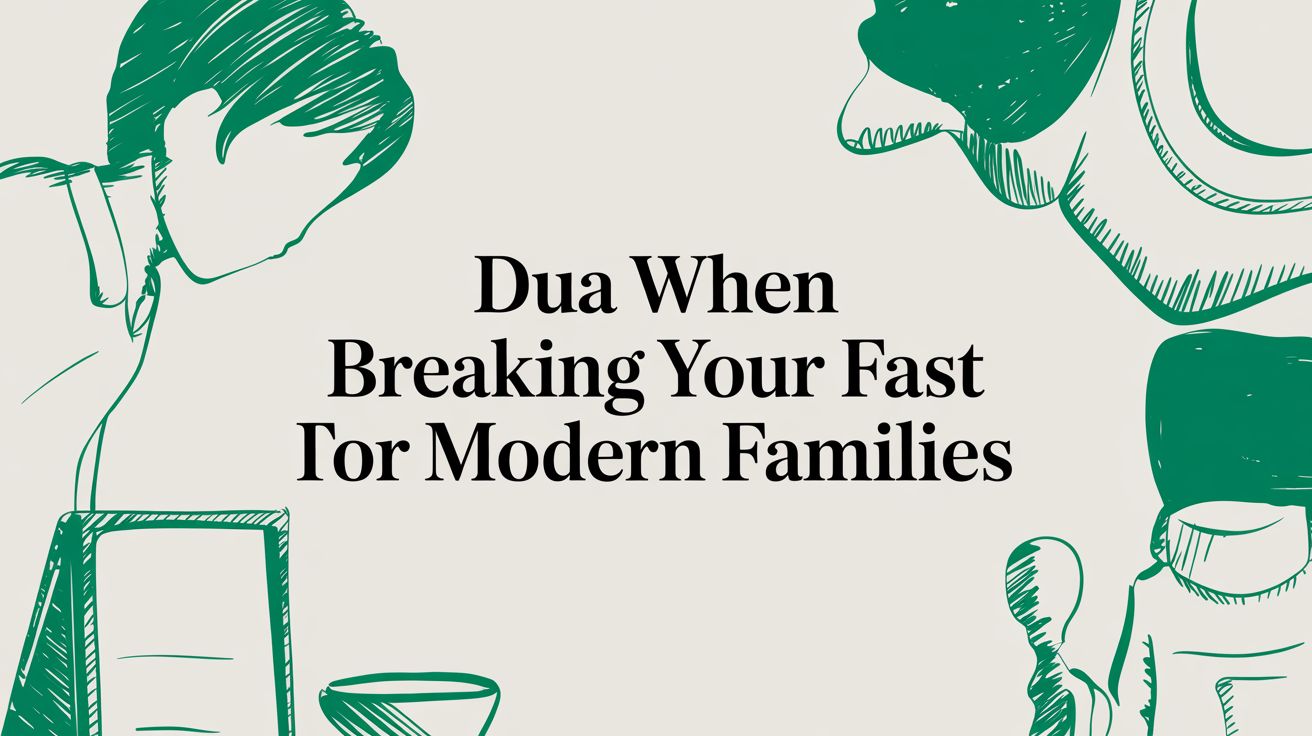Ever notice how a simple shape toy can captivate a toddler? It's far more than just a distraction. Toys like shape sorters and puzzles are actually a child's first real introduction to hands-on learning, blending the joy of play with some serious brain-building.
The Foundation of Play: Why Shape Toys Matter
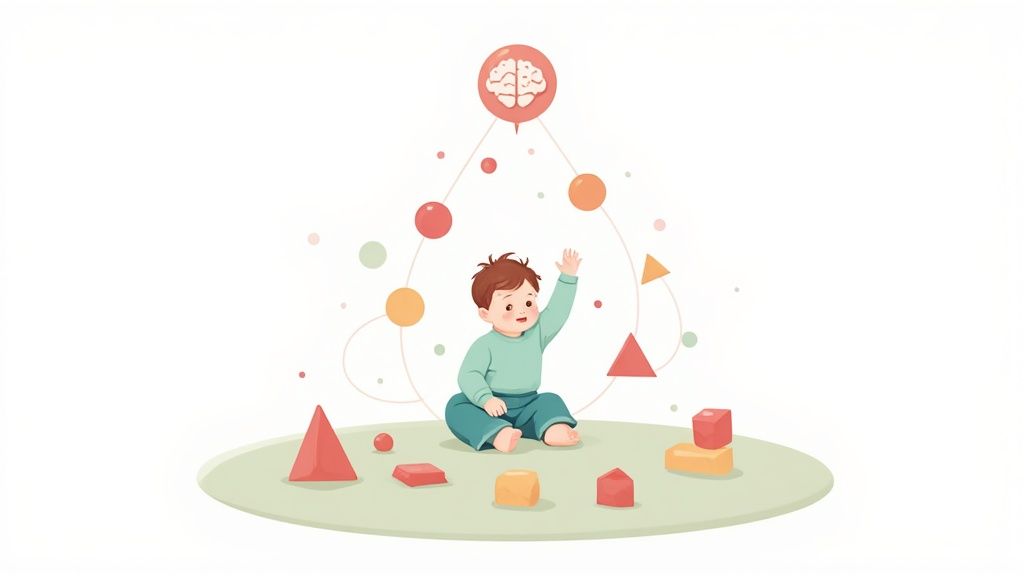
It's easy to look at a colorful shape sorter and just see a simple plaything. But for a toddler, it's one of the first and most important educational tools they'll ever encounter. Think of basic shapes as the alphabet of the world around us—a fundamental language your little one starts to understand through touch, sight, and a whole lot of trial-and-error.
That moment a toddler finally pushes a square block through the matching square hole? That’s not just a game. It’s a tiny masterclass in logic and spatial reasoning. Their brain is firing on all cylinders, forging connections that will lay the groundwork for understanding math and science down the road.
Building Blocks for the Brain
Every time your child plays with a shape toy, they're hitting critical developmental milestones. This isn't just about memorizing the words "circle" or "triangle." It's about getting a real feel for these objects—their edges, their corners, their curves—and figuring out how they fit into the bigger picture.
This hands-on exploration is a surprisingly powerful teacher. Here’s a peek at what's really going on:
* Problem-Solving: When that star block just won't fit into the circle hole, your child is learning a fundamental lesson in persistence and logic. They're experimenting and adjusting their approach until they succeed.
* Spatial Awareness: They start to grasp concepts like "in," "out," "around," and "through" in a very real, tangible way. It’s no longer an abstract idea but a physical experience.
* Fine Motor Skills: The act of grasping, turning, and carefully placing each shape is a workout for the small muscles in their hands and fingers, building the dexterity they'll one day need for writing.
At its core, shape-based play teaches a child how to observe, predict, and act. This three-step process is the foundation for critical thinking, building a resilient and curious mind.
This kind of focused play beautifully sets the stage for more advanced learning later on. In much the same way you might wonder what flash cards are and how they help with memory, shape toys build a visual and tactile memory bank. Each correctly sorted shape is a small victory, a little confidence boost that encourages them to take on the next challenge and builds a genuine love for discovery.
How Shape Toys Unlock Your Toddler's Potential
Shape toys are so much more than a way to keep little hands busy. They are powerful, hands-on tools that are literally building your toddler's brain, one block at a time. When your child tries to fit a star block into a square hole, they aren't just playing—they're running a complex mental and physical experiment.
This simple, engaging act unlocks potential across four key areas of growth. Each successful match is a tiny victory that wires their brain for future learning.
Boosting Cognitive Skills
The most obvious win with shape toys is the boost to cognitive development. As your toddler plays, they're learning to tell the difference between circles, squares, and triangles. This is their very first, hands-on introduction to geometry and sorting, skills that lay the foundation for logical thinking and math down the road.
Every time they work to find the right slot for a piece, they’re flexing their problem-solving muscles. You can see the gears turning: they might try forcing a piece, then rotating it, then moving to a different slot altogether. This trial-and-error process teaches them to look at a problem and test solutions until one clicks.
It’s also a fantastic memory workout. Soon enough, they start to remember which shape goes where, getting faster and more confident with every play session.
Developing Fine Motor Control
Pushing, turning, and placing shapes into a sorter is a fantastic workout for a toddler's hands. These precise movements are all about developing fine motor skills—the coordination of small hand and finger muscles with their eyes.
- Hand-Eye Coordination: Your child sees the slot and has to guide their hand to place the shape just right.
- Pincer Grasp: Picking up smaller shapes naturally encourages them to use their thumb and forefinger, a skill they'll need later for holding a crayon.
- Wrist Dexterity: Twisting and turning a block to make it fit strengthens their wrist, which allows for much more controlled movements.
This physical practice isn't just about building strength; it's about developing precision. The ability to handle objects with control is fundamental for all sorts of future tasks, like buttoning a shirt, using a fork, and eventually, writing their name.
Nurturing Language and Emotional Growth
Shape toys open up wonderful moments for conversation. As you play alongside your child, you can name the shapes ("This is the circle!") and colors ("Let's find the blue square!"). You can naturally introduce positional words like "in," "on," and "under," expanding their vocabulary in a way that makes sense to them. You can even bring in other fun concepts, like pairing shapes with the sounds of different animals. To learn more, check out our guide on how to teach animal sounds for toddlers.
Emotionally, these toys are quietly teaching patience and persistence. It’s frustrating when a piece just won't fit! Working through that small frustration to finally get it right builds resilience and a huge sense of accomplishment. It’s a powerful, unspoken lesson in emotional regulation.
It’s no surprise that parents are increasingly seeking out toys with these kinds of benefits. The educational toy market was valued at a huge $25.42 billion and is expected to hit $44.17 billion by 2035. This incredible growth shows just how much parents are prioritizing play that truly helps their children develop.
Choosing the Right Shape Toy for Your Toddler
Walking down the toy aisle can be overwhelming. With so many colors, materials, and designs, how do you pick the perfect shape toy for your little one? The secret is matching the toy's complexity to your child's developmental stage. Think of it like buying shoes—the right fit supports confident steps, but a poor fit just leads to frustration.
For the youngest learners, simple is always better. Start with toys that have big, chunky pieces and just a few basic shapes, like a circle or a square. A simple puzzle with only three or four pieces can provide the perfect amount of challenge without feeling impossible. As they get more confident and their skills sharpen, you can introduce more complex sorters with a greater variety of shapes.
Safety and Materials First
When it comes to our little ones, safety is everything. Toddlers explore the world with their hands and their mouths, so what their toys are made of is a huge deal. Always make sure you're choosing toys made from non-toxic, child-safe materials.
Here’s a quick checklist for safe toy shopping:
* Non-Toxic Finishes: Look for labels confirming that any paints or finishes are lead-free and non-toxic.
* BPA-Free Plastics: If you opt for plastic toys, make sure they are BPA-free, phthalate-free, and ideally made from food-grade plastic.
* No Small Parts: Check for any small, detachable pieces that could be a choking hazard. A great rule of thumb is the toilet paper tube test—if a part can fit through the tube, it’s too small for a toddler.
* Durable Construction: The toy needs to be tough enough to handle being dropped, thrown, and chewed on without splintering or breaking into sharp bits.
The goal is to create a safe play environment where your child can explore freely. A well-chosen toy offers peace of mind, allowing you to focus on the joy of watching them learn and discover.
This diagram shows how shape play supports a toddler's development across cognitive, motor, and language domains.
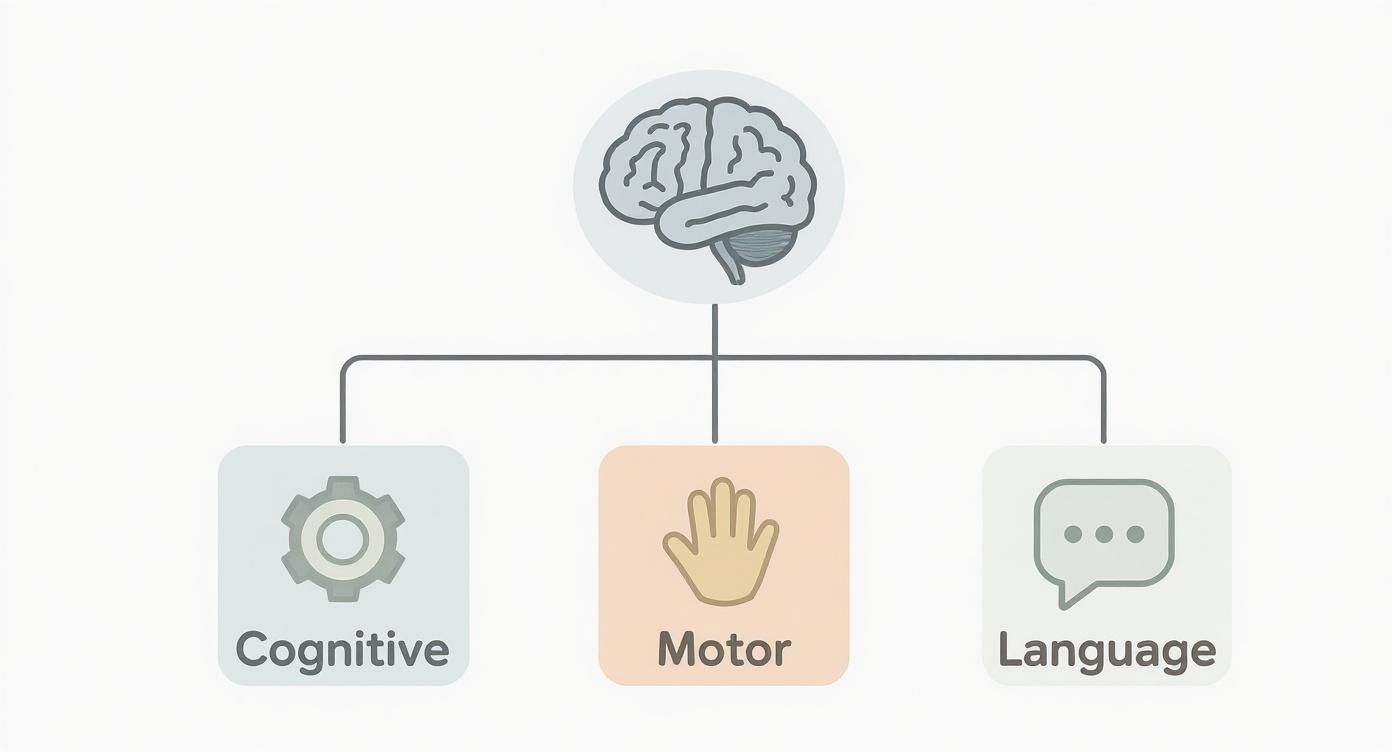
As you can see, these three core areas are deeply interconnected. When your child makes progress in one area, it often gives them a boost in the others, too.
Matching Toys to Your Child's Age
Choosing a toy that’s right for your toddler's age is the key to keeping them engaged and happy. The best shape toys for toddlers are the ones that can grow with them, supporting their budding skills at each new milestone.
To make it easier, here’s a quick guide to help you find the perfect fit for your child's age and stage.
Age-Appropriate Shape Toy Selection Guide
| Age Range | Recommended Toy Type | Key Developmental Focus |
|---|---|---|
| 1 Year | Simple sorters (1-2 large shapes) | Basic hand-eye coordination, cause and effect |
| 2 Years | Sorters with 3-5 basic shapes | Shape recognition, fine motor skills, vocabulary building |
| 3 Years | Complex sorters, multi-step puzzles | Problem-solving, spatial reasoning, finer motor control |
Let's break that down a bit more.
A one-year-old is just getting the hang of hand-eye coordination. They’ll get the most out of a very simple shape sorter with one or two big, distinct shapes. At this age, it’s all about the fun of dropping an object into a container.
By age two, toddlers are ready for a bigger challenge. They can typically handle toys with three to five different shapes, like circles, squares, and triangles. This is also when they start recognizing and naming shapes, turning playtime into a fantastic opportunity to build their vocabulary.
Once your child hits three, you can introduce more complex sorters that demand finer motor skills and better spatial awareness. Look for toys with trickier shapes like stars, hexagons, or ovals. This is also a fantastic age for multi-step puzzles that really stretch their problem-solving muscles and teach them a bit of patience along the way.
Creative and Engaging Play Ideas with Shape Toys
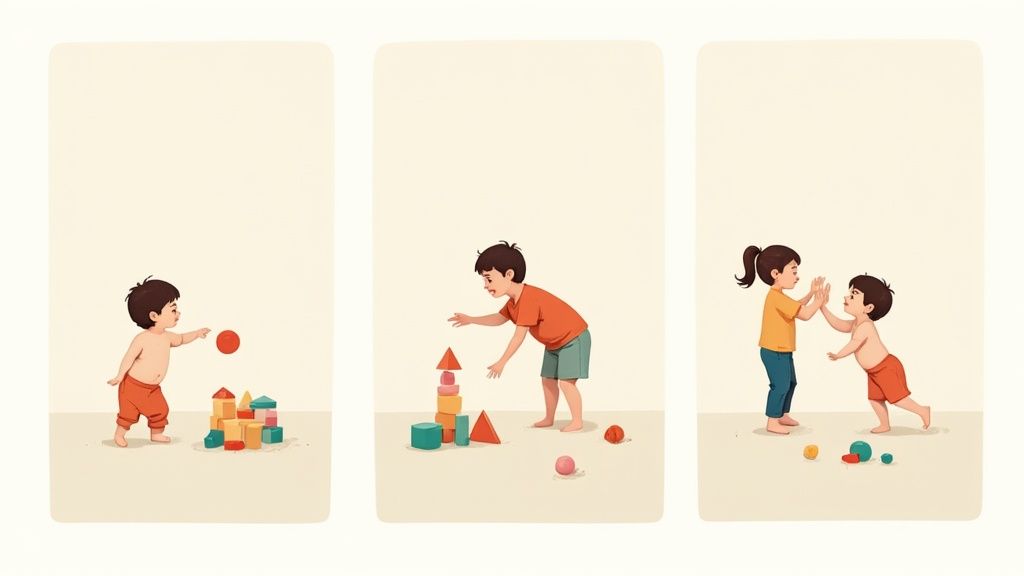
A shape toy isn't just one toy; it’s a whole universe of play waiting to be discovered. The real magic begins when you scaffold the activities—starting with the simplest tasks and slowly adding layers of complexity. This little trick keeps your toddler engaged and turns a basic set of shapes into a powerful learning experience.
The key is to see the toy not just for what it is, but for what it can become. A simple sorter can be a construction set, and puzzle pieces can become characters in a story. This kind of open-ended play is where creativity, problem-solving, and genuine confidence start to bloom.
Starting with Simple Sorting
For the youngest toddlers, the journey starts with the basics. Don't overwhelm them. Just isolate one or two shapes to begin. Hand your child a circle and gently guide their hand toward the matching circular hole. Every time they succeed, celebrate it with warm, positive words like, “Masha’Allah! You found the circle’s home!”
Once they get the hang of it, you can introduce more shapes and start naming them. This early stage is all about building foundational skills in a fun, pressure-free way.
- Shape Hunt: Place the sorter on one side of the room and the shapes on the other. Call out a shape and watch them toddle over to find it and bring it back to its slot.
- Color Matching: After they know the shapes, switch the focus to colors. Try asking, "Can you find the red square?" or "Let’s put all the blue shapes in the box."
Building and Creating Pictures
Once your little one is comfortable with sorting, it's time to unleash their inner artist and architect. Those individual shapes are no longer just pieces of a puzzle; they're now the building blocks of their imagination.
Encourage them to stack the shapes to build a tower. It’s a simple activity, but it’s a fantastic first lesson in balance and physics. You can also lay the shapes flat on the floor to create simple pictures—two circles become a car's wheels, while a square and a triangle make a house.
This transition from sorting to building is a huge cognitive leap. It moves your child from just recognizing patterns to creating their own, which is a fundamental step toward developing abstract thought and creative expression.
These activities foster a much deeper understanding of how shapes combine to form the world around them. For more ideas on blending visuals and stories, you can explore our guide on using ABC stories with ASL to create a rich, multi-sensory learning experience.
Advanced Sorting and Pattern Play
As your toddler's skills sharpen, you can introduce challenges that require a bit more brainpower. This is where you can mix and match concepts like shape and color into a single, fun activity.
- Two-Variable Sorting: Create separate piles for "red circles" and "blue squares." This teaches them to sort objects based on more than one attribute at the same time—a key pre-math skill!
- Simple Patterns: Lay out a basic pattern like "circle, square, circle, square" and ask your toddler what comes next. This is a playful introduction to early mathematical concepts.
- Shape Storytelling: Let the shapes become characters. A triangle can be a mountain, a circle can be the sun, and a rectangle can be a boat. This imaginative play is a powerful booster for language and narrative skills.
It's no surprise that the global market for infants' and toddlers' toys, including these developmental tools, was valued at $16.7 billion. The specific segment for activity and developmental toys, where shape sorters are a star player, accounted for $3.7 billion of that market and is expected to grow at a 6% annual rate. This just goes to show how much parents everywhere value this kind of interactive, skill-building play. By turning playtime into a creative adventure, you’re giving your child skills that will last a lifetime.
Your Guide to Safe and Sustainable Shape Toys
When you’re looking for a new toy, nothing matters more than your child’s safety. It's the number one priority. In a market flooded with options, knowing what to look for in terms of materials and safety standards can give you real peace of mind.
Before you bring any new shape toys for toddlers home, a quick safety check is a must. Little ones explore the world with their mouths, hands, and whole bodies, so their toys have to be tough enough to handle it and made from completely safe, non-toxic materials.
Here’s a simple mental checklist to run through:
- Look for Safety Certifications: Keep an eye out for labels like ASTM (American Society for Testing and Materials) or CE (Conformité Européenne). These little marks mean the toy has passed strict international safety tests.
- Avoid Small Parts: The old "toilet paper tube" trick still works wonders. If any part of the toy can slip through a standard cardboard tube, it's a potential choking hazard for a child under three.
- Inspect for Durability: Give the toy a good once-over. Are there any sharp edges, potential splinters, or weak spots that look like they could snap off during a lively play session?
Choosing the Right Materials
The material a toy is made from impacts everything—its safety, how long it will last, and even its footprint on the environment.
Wooden toys are a classic for a reason. They feel wonderful to touch, they’re incredibly durable, and they have a natural, timeless quality. If you’re going with wood, look for the FSC (Forest Stewardship Council) certification. This guarantees the wood was sourced from forests managed with care and responsibility.
Of course, plastic and silicone toys have their benefits, too. They’re usually lightweight, a breeze to clean, and can be very resilient. The key is to choose plastics that are clearly labeled as BPA-free and phthalate-free, steering clear of any potentially harmful chemicals.
A toy’s journey doesn’t end when your child outgrows it. Choosing sustainable materials like FSC-certified wood or recycled plastics is a small but meaningful way to care for Allah’s creation and teach your child the value of stewardship from an early age.
It's clear parents everywhere are focusing more on developmental tools. The market for these kinds of toys is currently valued at around $15 billion and is expected to grow by 7% each year through 2033. This isn't just a trend; it shows a real shift in how we think about play—we want toys that are fun, safe, educational, and made with intention. You can discover more insights about the developmental toys market and see what's driving this growth.
In the end, whether you prefer the warm, natural feel of wood or the easy-to-clean practicality of high-quality silicone, the goal is the same. When you choose safe and sustainable shape toys, you’re making sure playtime is healthy, joyful, and good for everyone.
Common Questions About Shape Toys for Toddlers
When you're bringing a new toy into the house, questions are bound to pop up. It's just part of being a thoughtful parent! Shape toys are a staple for early development, but knowing the right time and approach can make all the difference. Let's tackle some of the things you might be wondering about.
When Should I Introduce a Shape Sorter?
You can start thinking about a simple shape sorter right around your child's first birthday. This is when their pincer grasp is getting stronger, and they're completely fascinated by cause and effect. Dropping a block and hearing it thunk inside a box is pure magic to them.
Start with a sorter that has just one or two big, easy-to-handle shapes, like a circle and a square. The goal at first isn't for them to match the shapes perfectly. It's all about the exploration—building that crucial hand-eye coordination and getting the hang of posting objects into slots. Once they hit around 18 months, you'll see their little brains start to connect the dots between a shape and its matching hole.
How Do I Clean Different Toy Materials?
Let's be real: toddler toys spend a lot of time in mouths, so keeping them clean is non-negotiable. The best way to clean them really depends on what they're made of.
- Wooden Toys: The golden rule with wood is: don't soak it. Water can make it swell up and lose its shape. A simple wipe-down with a damp cloth and a gentle solution of either mild soap or vinegar and water works perfectly. Just let them air-dry completely before they go back into the toy bin.
- Plastic and Silicone Toys: These are usually much simpler to clean. A good wash with warm, soapy water is often all you need. Many are even safe for the top rack of the dishwasher, which is a lifesaver for busy parents. Just be sure to give the manufacturer's instructions a quick look first.
A regular cleaning routine makes for a safe and healthy play space where your little one can explore without you having to worry.
What if My Toddler Isn't Interested?
First off, don't panic! If your toddler gives a new shape toy the cold shoulder, it’s not a big deal. Their interests can change in the blink of an eye, and every child moves at their own unique pace. If they seem more frustrated than engaged, the toy might just be a little ahead of their current developmental stage.
The key is to make it a shared, low-pressure activity. Sit with them on the floor, play with the shapes yourself, and model the fun. Your engagement is often the most inviting element.
Try putting the toy away for a couple of weeks. When you bring it out again, you might be surprised to find them suddenly fascinated by it. A little time and a lot of patience are your best friends here.
Ready to provide your child with safe, engaging, and faith-aligned screen time that complements their hands-on learning? Join the waitlist for Babymode, the ad-free, halal platform designed for Muslim families. Get early access and special launch pricing at babymode.ai.
